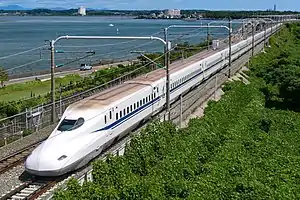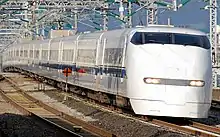Nozomi (train)
Nozomi (のぞみ, "Wish" or "Hope") is the fastest train service running on the Tokaido & San'yō Shinkansen lines in Japan. The service stops at only the largest stations, and along the stretch between Shin-Ōsaka and Hakata, Nozomi services using N700 series equipment reach speeds of 300 km/h (186 mph). The trip between Tokyo and Osaka, a distance of 515 kilometres (320 mi), takes 2 hours 21 minutes on the fastest Nozomi service, with the fastest service between Tōkyō and Hakata taking 4 hours 46 minutes.[1]
 N700A Series Nozomi, September 2021 | |
| Overview | |
|---|---|
| Service type | Shinkansen |
| First service | 1934 (Express) 1992 (Shinkansen) |
| Current operator(s) | JR Central, JR West |
| Route | |
| Termini | Tokyo Hakata |
| Line(s) used | Tōkaidō Shinkansen San'yō Shinkansen |
| On-board services | |
| Class(es) | Green/standard |
| Catering facilities | Trolley service |
| Technical | |
| Rolling stock | N700 series, N700S series |
| Track gauge | 1,435 mm (4 ft 8+1⁄2 in) standard gauge |
| Electrification | 25 kV AC overhead |
| Operating speed | 300 km/h (190 mph) (San'yō Shinkansen) 285 km/h (180 mph) (Tōkaidō Shinkansen) |
The trains stop at fewer stations than the Hikari and Kodama trains. On the Tōkaidō Shinkansen between Tokyo and Shin-Ōsaka, Nozomi trains stop only at Shinagawa, Shin-Yokohama, Nagoya and Kyōto.[1] On the Sanyō Shinkansen between Shin-Ōsaka and Hakata, all Nozomi trains stop at Shin-Kobe, Hiroshima, Okayama and Kokura, with certain trains also stopping at additional stations.
The Nozomi service is not valid for foreigners traveling with a Japan Rail Pass, one of only two Shinkansen services with such a distinction - the other is the Mizuho service on the San'yō and Kyūshū Shinkansen lines.[2]
Stopping patterns (as of May 2019)
Legend
| ● | All trains stop |
|---|---|
| ○ | Some trains stop |
| △ | Few trains stop |
Only basic Nozomi stopping patterns are shown. Additional Nozomi trains with differing stopping patterns are added during holiday and high-peak travel periods, and are not included in this table.
| Station | Distance (km) (from Tokyo) |
Tokyo - Hakata1 | Tokyo- Shin-Osaka2 |
Nagoya - Hakata |
|---|---|---|---|---|
| Tokyo | 0.0 | ● | ● | |
| Shinagawa | 6.8 | ● | ● | |
| Shin-Yokohama | 25.5 | ● | ● | |
| Nagoya | 342.0 | ● | ● | ● |
| Kyoto | 476.3 | ● | ● | ● |
| Shin-Ōsaka | 515.4 | ● | ● | ● |
| Shin-Kobe | 548.0 | ● | ● | |
| Nishi-Akashi | 570.2 | △ | - | |
| Himeji | 601.3 | ○ | - | |
| Okayama | 676.3 | ● | ● | |
| Fukuyama | 733.1 | ○ | ○ | |
| Hiroshima | 821.2 | ● | ● | |
| Tokuyama | 903.5 | ○ | - | |
| Shin-Yamaguchi | 944.6 | ○ | ○ | |
| Kokura | 1013.2 | ● | ● | |
| Hakata | 1069.1 | ● | ● |
Note:
1 Some trains begin/terminate at Nishi-Akashi, Himeji, Okayama or Hiroshima.
2 Some trains begin/terminate at Nagoya.
Rolling stock
Current rolling stock
- N700 series (July 2007 – )
- N700S series (July 2020 – )
 N700 series, June 2008
N700 series, June 2008 N700S series, September 2021
N700S series, September 2021
Former rolling stock
- 300 series (March 1992 – March 2012)
- 500 series (March 1997 – June 2008)
- 700 series (March 1999 – March 2020)[3]
 300 series, February 2011
300 series, February 2011 500 series, February 2010
500 series, February 2010 700 series, January 2008
700 series, January 2008
Formations
N700 series / N700S series
Trains are formed as shown below, with car 1 at the Hakata end, and car 16 at the Tokyo end.[4][5]
| Car no. | 1 | 2 | 3 | 4 | 5 | 6 | 7 | 8 | 9 | 10 | 11 | 12 | 13 | 14 | 15 | 16 |
|---|---|---|---|---|---|---|---|---|---|---|---|---|---|---|---|---|
| Class | Standard | Standard | Green | Standard | ||||||||||||
| Non-reserved | Reserved | Reserved | Reserved | |||||||||||||
| Facilities | WC | WC / smoking compartment | Cardphone | WC | Vending machine | WC / smoking compartment | WC / cardphone | Smoking compartment | Vending machine / WC / wheelchair space | Cardphone | WC | Smoking compartment / WC / cardphone | ||||
| Smoking | ||||||||||||||||
(All cars are completely non-smoking, except for enclosed smoking compartments located in cars 3, 7, 10, and 15)
Future plans
In an announcement by JR Central, JR West, and JR Kyushu made on 17 October 2023, the companies stated that all onboard smoking rooms on the Tokaido, San'yo, and Kyushu Shinkansen trains would be abolished by Q2 2024.[6] In addition, all smoking rooms located on station platforms on the aforementioned Shinkansen lines would also be abolished.[6]
 N700 series Green car interior
N700 series Green car interior N700 series standard-class car interior
N700 series standard-class car interior An internationally recognizable "No Smoking sign"
An internationally recognizable "No Smoking sign"
700 series
Services formerly operated with 700 series sets until their removal in March 2020 were as follows:[7]
| Car No. | 1 | 2 | 3 | 4 | 5 | 6 | 7 | 8 | 9 | 10 | 11 | 12 | 13 | 14 | 15 | 16 |
|---|---|---|---|---|---|---|---|---|---|---|---|---|---|---|---|---|
| Class | Standard Non-reserved | Standard Non-reserved | Standard Non-reserved | Standard Reserved | Standard Reserved | Standard Reserved | Standard Reserved | Green Reserved | Green Reserved | Green Reserved | Standard Reserved | Standard Reserved | Standard Reserved | Standard Reserved | Standard Reserved | Standard Reserved |
| Facilities | WC | Cardphone | WC / vending machine | WC | Cardphone | WC | WC | Vending machine / WC / wheelchair space | Cardphone | WC | Vending machine / WC / cardphone | |||||
| Smoking |
History
Wartime steam services
The Nozomi name was first used for long-distance express services operated between Busan in Japanese-occupied Korea and Mukden (now Shenyang) in the former Manchukuo (now China) from 1934.[8] From 1938, the services were extended to run between Busan and Hsinking (now Changchun) in Manchukuo. The 1,530 km journey from Busan to Hsinking took over 29 hours, with an average speed of 52 km/h (32 mph). The services were run down between 1943 and 1944.[8]
Shinkansen services
Nozomi shinkansen services commenced on March 14, 1992, using new 300 series trainsets with a top speed of 270 km/h. From March 1997, 500 series trainsets were introduced on Tokyo - Hakata Nozomi services, running at a maximum speed of 300 km/h and covering the section between Shin-Osaka and Hakata in 2 hours 17 minutes.
700 series trains were introduced on Nozomi services in 1999, and N700 series trains were introduced from July 1, 2007, initially with four daily round-trip runs. All regularly scheduled through Nozomi services to the San'yō Shinkansen (Tokyo–Hakata) were operated by N700 series sets from 13 March 2010. From the start of the revised timetable on 17 March 2012, all regularly scheduled Nozomi services, including runs limited to the Tokaido Shinkansen, were operated by N700 series sets.
Effective December 2023, JR Central and JR West will adjust all Nozomi services to operate completely with reservations during three seasons that experience the highest ridership: New Years and Christmas (late December thru the first week of January), Golden Week (29 April to 5 May), and the Obon festival (mid to late August).[9] These adjustments will be made in a bid to increase seat patronage and reduce the amount of standing passengers.[9]
References
- JR新幹線&特急列車ファイル [JR Shinkansen & Limited Express Train File]. Japan: Kōtsū Shimbun. 2008. ISBN 978-4-330-00608-6.
- JR Timetable, March 2008 issue
- Hyperdia: Shin-Osaka–Tokyo timetable for 2009-06-11
- "About Japan Rail Pass". Japan: Japan Railways Group. Archived from the original on 19 June 2017. Retrieved 29 March 2015.
- "新幹線700系の8日ラストラン取りやめ 感染拡大防止で 1日が最後の運行に" [700 Series Shinkansen Last Run Cancelled]. mainichi.jp (in Japanese). Mainichi. 2 March 2020. Archived from the original on 3 March 2020. Retrieved 4 March 2020.
- JR Timetable, August 2011, p.997
- 新幹線 車両大全 [Shinkansen Cars Encyclopedia]. Tokyo, Japan: Ikaros Publications Ltd. November 2011. pp. 60–135. ISBN 978-4-86320-526-0.
- Kinoshita, Kenji (17 October 2023). "東海道・山陽・九州新幹線の車内喫煙ルーム、2024年春にすべて廃止" [All smoking rooms on Tokaido, Sanyo, and Kyushu Shinkansen trains will be abolished in spring 2024.]. MyNavi Corporation. Archived from the original on 18 October 2023. Retrieved 19 October 2023.
- "新幹線700系の8日ラストラン取りやめ 感染拡大防止で 1日が最後の運行に" [700 Series Shinkansen Last Run Cancelled]. mainichi.jp (in Japanese). Mainichi. 2 March 2020. Archived from the original on 3 March 2020. Retrieved 4 March 2020.
- JR急行・快速列車 [JR Express & Rapid Trains]. Tokyo, Japan: Railway Journal. 2 November 1991. p. 127.
- "JR東海・JR西日本,3大ピーク期に"のぞみ"を全席指定席で運転" [JR Central and JR West to Discontinue Non-Reserved Seats on all Nozomi Services during Three Major Holidays]. Japan Railfan Magazine Online (in Japanese). 14 September 2023. Archived from the original on 14 September 2023. Retrieved 15 September 2023.


